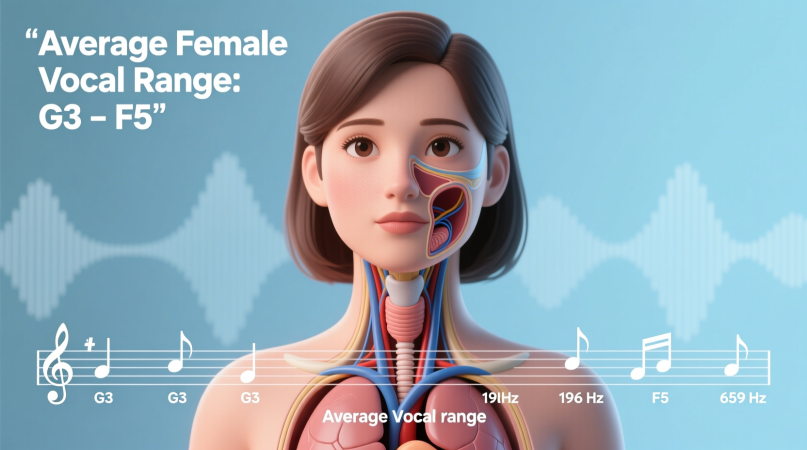
When people talk about great singers, one of the first things that comes up is “her range.” From opera houses to pop charts, female vocalists are admired for how high (or low) they can sing. But what does the average vocal range for a female actually look like?
This guide breaks down the numbers, explains the different voice types, and gives you tips to measure and understand your own range.
Understanding Vocal Range
A vocal range is the span between the lowest and highest notes a singer can produce. It’s usually described in octaves.
- From A3 to A4 = one octave.
- From A3 to A5 = two octaves.
It’s important to separate:
- Usable range: the notes you can sing consistently with control and good tone.
- Extreme range: the very top or bottom notes you might only hit occasionally.
When we talk about the average female vocal range, we mean the usable span for most women.
The Average Female Vocal Range
Most research and vocal coaches agree:
- The average female vocal range is about 2 to 3 octaves.
- Typically this sits between A3 and A5 (sometimes C6).
This means most women can comfortably cover everyday singing tasks, from pop melodies to choir parts.
👉 Want to see where your voice sits? Try testing with an online vocal range calculator.
Female Voice Types Explained
Classical music and vocal training use categories called fach to describe voices. Here’s how they map:
| Voice Type | Typical Range | Notable Singers |
|---|---|---|
| Soprano | C4 – C6 | Whitney Houston, Ariana Grande |
| Mezzo-Soprano | A3 – A5 | Adele, Lady Gaga |
| Contralto (Alto) | F3 – F5 | Toni Braxton, Cher |
Most women fall in the mezzo-soprano category, which aligns with the A3–A5 average. Sopranos sit higher, while contraltos hold down the lowest female parts.
Female vs Male Averages
How do women compare to men?
- Female average: 2–3 octaves (A3–A5 or C6)
- Male average: 1.5–2 octaves (F2–E4)
This difference explains why choirs and vocal groups sound balanced: female voices cover higher harmonics while male voices cover the lows.
If you’re curious about the male side, check our breakdown of the average male vocal range.
Famous Singers Who Break the Average
While most women land in the 2–3 octave zone, some extraordinary singers go far beyond:
- Mariah Carey – ~5 octaves, including whistle register
- Ariana Grande – ~4 octaves, strong mix of head voice and whistle tones
- Whitney Houston – ~3 octaves, legendary soprano power
- Christina Aguilera – ~4 octaves, agile belts and runs
These artists remind us that the “average” is just a starting point—your voice can be unique and special even within a smaller span.
What Influences Female Vocal Range?
Several factors shape where your voice sits:
- Physiology: Vocal cord length and thickness.
- Age & hormones: Ranges can shift during adolescence, pregnancy, and menopause.
- Training: Technique and breath support expand usable notes.
- Health & lifestyle: Smoking, dehydration, or strain can limit range.
How to Measure Your Range
Here’s a simple way to find your own range:
- Warm up your voice.
- On a piano or app, descend to your lowest comfortable note.
- Then climb slowly to your highest clear note.
- Write down the span (e.g., G3–C6).
- Count the octaves (every 12 semitones = 1 octave).
For accuracy, log your range using a vocal range test tool so you can track changes over time.
Tessitura vs Range
A key concept often overlooked is tessitura—the section of your range where your voice sounds richest and feels easiest.
- Example: You may span from A3 to C6, but your tessitura might sit around C4 to A5.
- This is usually what determines your comfort in singing styles or roles.
For most singers, tessitura matters more than chasing extra octaves.
Myths About Female Vocal Range
- Myth 1: “Bigger is always better.” Not true—clarity, tone, and emotion are more important.
- Myth 2: “You need 3 octaves to sing professionally.” Many famous singers work within 2.
- Myth 3: “Range doesn’t change.” With training, many women add notes safely over time.
FAQs
What is the average female vocal range?
Around 2–3 octaves, usually A3–A5 (sometimes extending to C6).
Which female voice type is most common?
Mezzo-soprano, which sits in the middle.
Can training increase my range?
Yes. With safe exercises, most singers can expand by half an octave or more.
Does age affect female range?
Yes. Younger women often have brighter highs; hormonal changes can deepen or shift range over time.
Who has the widest female vocal range?
Mariah Carey is famous for her five-octave range, one of the widest ever recorded.
